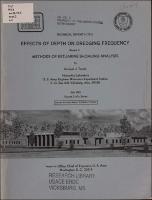Please use this identifier to cite or link to this item:
https://hdl.handle.net/11681/13681| Title: | Effects of depth on dredging frequency. Report 2, Methods of estuarine shoaling analysis |
| Authors: | Operations and Maintenance Improvements Program Trawle, Michael J. |
| Keywords: | Channel improvement Dredging Harbors Maintenance dredging Shoaling Estuaries Estuary Maintenance Repair Sedimentation Deposition |
| Publisher: | Hydraulics Laboratory (U.S.) Engineer Research and Development Center (U.S.) |
| Series/Report no.: | Technical report (U.S. Army Engineer Waterways Experiment Station) ; H-78-5 rept.2. |
| Description: | Technical Report Abstract: Whenever deepening of a dredged channel is under investipation, a prediction must be made as to the effect of the deepening on the existing dredging requirements. If the deepening is related to advance maintenance dredging rather than to an increase in authorized depth, the prediction becomes even more difficult because the project is allowed to shoal over a wide range of depth. Currently a variety of arbitrary, rule-of- thumb procedures are used for predicting the effect of increased depth on dredging requirements. The overall objective of this investigation was to evaluate the effectiveness of advance maintenance dredging in reducing dredging frequency and/or costs in the maintenance of coastal channels and harbors and to establish necessary guidelines for governing the practice. This report, the second of a series, presents an empirical method of shoaling analysis based on historical dredging and shoaling records that results in reliable predictions of future shoaling for deepened channel conditions resulting from either an increase in authorized channel depth or advance maintenance. The method presented was designed to be general enough so that it can be applied to most navigation projects without difficulty. The procedure was described step by step using an example (fictitious) project. To demonstrate how the method would be applied to real navigation projects and to point out problems that occur when evaluating real projects, selected Galveston Bay, Texas, navigation projects were evaluated and the results discussed. |
| Rights: | Approved for public release; distribution is unlimited. |
| URI: | http://hdl.handle.net/11681/13681 |
| Appears in Collections: | Technical Report |
Files in This Item:
| File | Description | Size | Format | |
|---|---|---|---|---|
| TR-HL-78-5-Report-2.pdf | 10.59 MB | Adobe PDF |  View/Open |